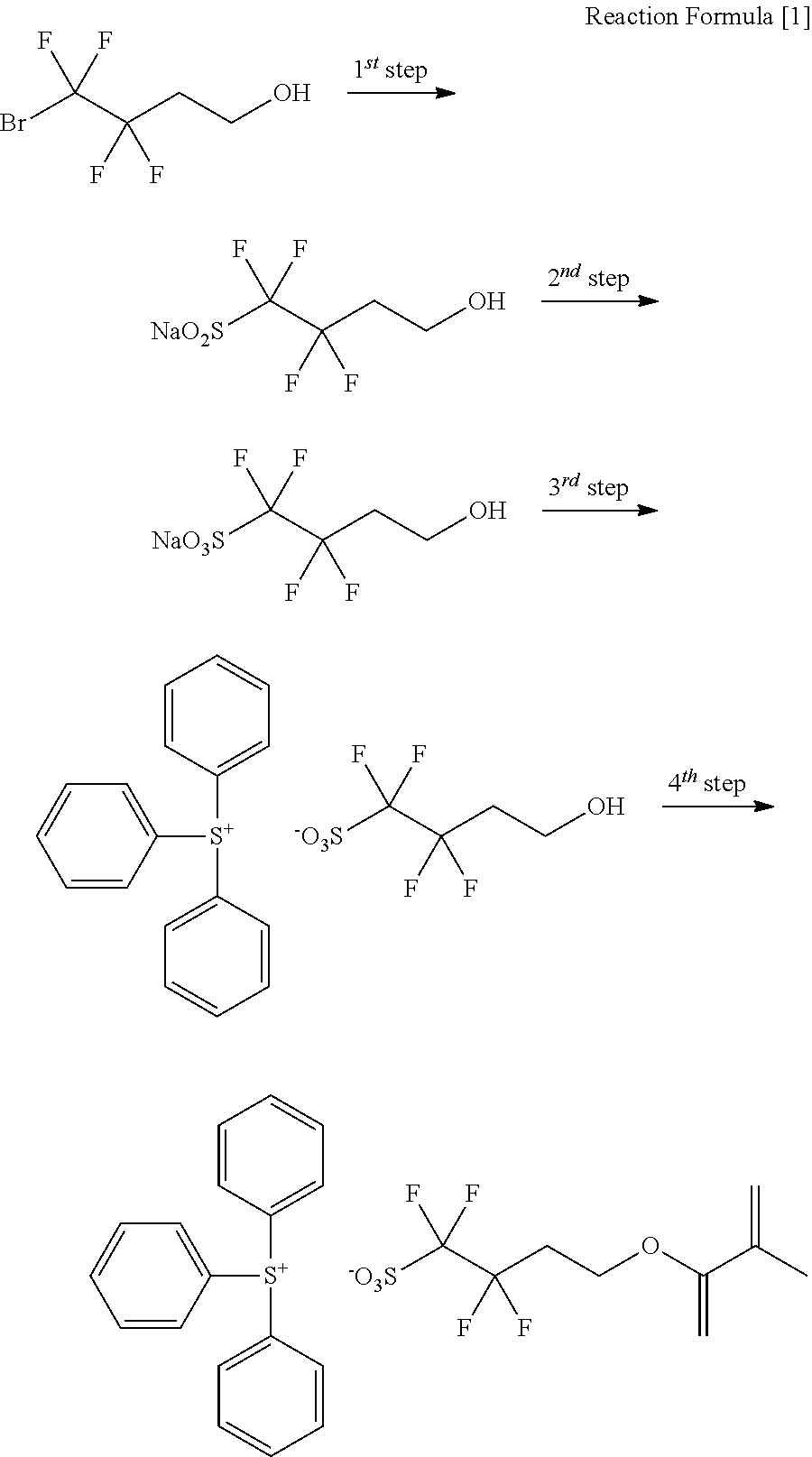Fluoroalkanesulfonic Acid Ammonium Salts and Method for Producing Same
- Summary
- Abstract
- Description
- Claims
- Application Information
AI Technical Summary
Benefits of technology
Problems solved by technology
Method used
Image
Examples
example 1-1
Production of 6-bromo-5,5,6,6-tetrafluorohexane benzoate
The Previous Step: Esterification Step 1
[0219]
[0220]A 300 mL reactor was charged under nitrogen with 14.0 g (99.6 mmol / 1.3 equivalents) of benzoyl chloride and 150 mL of tetrahydrofuran (a dehydrated product), following by putting it in an ice bath. 20.0 g (79.0 mmol / 1.0 equivalent) of 6-bromo-5,5,6,6-tetrafluorohexan-1-ol was added thereto, followed by adding dropwise of 12.0 g (119 mmol / 1.5 equivalents) of triethylamine. After the dropping, stirring was conducted at 60 degrees for 10 hours. Then, 100 mL of water was added, and extraction was conducted two times with 200 mL of diisopropyl ether. The obtained organic layer was washed further with diluted hydrochloric acid, sodium bicarbonate water and brine, followed by removing water by sodium sulfate and conducting filtration. Then, isopropyl ether was distilled out, thereby obtaining 24.4 g of the target 6-bromo-5,5,6,6-tetrafluorohexane benzoate. Upon this, purity was 95%, ...
example 1-2
Production of triethylammonium 1,1,2,2-tetrafluoro-6-benzoyloxyhexane-1-sulfinato
First Step: Sulfinating Step
[0223]
[0224]A 200 mL reactor was charged with 20.0 g (purity 95%, 53.2 mmol) of 6-bromo-5,5,6,6-tetrafluorohexane benzoate obtained by Example 1-1, 50 g of acetonitrile, 40 g of water, 15.0 g (86.4 mmol / 1.6 equivalents) of sodium dithionite, and 9.8 g (97.2 mmol / 1.8 equivalents) of triethylamine in order, followed by stirring at 60° C. for 3 hours. The reaction liquid was separated into an organic layer and an aqueous layer. Acetonitrile was distilled out of the organic layer, followed by adding 40 mL of dichloromethane to prepare a dichloromethane solution. Extraction was conducted on the aqueous layer with 20 mL of dichloromethane, and this was combined with the organic layer. The obtained organic layer was washed with 10% sodium thiosulfate aqueous solution, water and brine, followed by distilling dichloromethane off, thereby obtaining 24.4 g of the target triethylammonium...
example 1-3
Production of triethylammonium 1,1,2,2-tetrafluoro-6-benzoyloxyhexane-1-sulfonato
Second Step: Oxidation Step
[0227]
[0228]A 200 mL reactor was charged with 20.0 g (purity 85%, 38.3 mmol) of triethylammonium 1,1,2,2-tetrafluoro-6-benzoyloxyhexane-1-sulfinato obtained by Example 1-2, 100 mL of water, 0.019 g (0.057 mmol / 0.0015 equivalents) of disodium tungstate dihydrate, and 6.1 g (53.6 mmol / 1.4 equivalents) of 30% hydrogen peroxide water, followed by stirring at room temperature for 3 hours. Then, the reaction liquid was ascertained by 19F NMR that triethylammonium 1,1,2,2-tetrafluoro-6-benzoyloxyhexane-1-sulfinato was completely consumed and that the production of 6-bromo-5,5,6,6-tetrafluorohexane benzoate as a by-product was <1%. Extraction was conducted two times on the reaction liquid with 40 mL of dichloromethane. Out of the obtained organic layer, the solvent was distilled, and the obtained solid matter was dried. The solid matter was dissolved in methanol, and insoluble matters...
PUM
 Login to View More
Login to View More Abstract
Description
Claims
Application Information
 Login to View More
Login to View More - R&D
- Intellectual Property
- Life Sciences
- Materials
- Tech Scout
- Unparalleled Data Quality
- Higher Quality Content
- 60% Fewer Hallucinations
Browse by: Latest US Patents, China's latest patents, Technical Efficacy Thesaurus, Application Domain, Technology Topic, Popular Technical Reports.
© 2025 PatSnap. All rights reserved.Legal|Privacy policy|Modern Slavery Act Transparency Statement|Sitemap|About US| Contact US: help@patsnap.com



